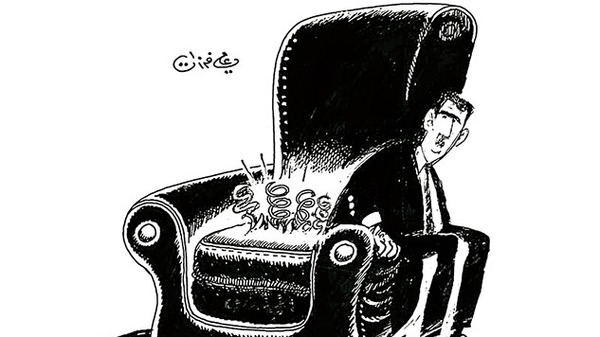Syrian artist Ali Farzat first started drawing cartoons of President Bashar al-Assad to “show people that they did not need to be scared anymore,” he told the Guardian this week, speaking from Kuwait, where he lives in exile.
“It was a big decision to start to draw Bashar and, yes, I was scared of what might happen, particularly when I was attacked,” Farzat told the newspaper in an interview published on Monday.
Farzat says he was attacked in August 2011, shortly after he drew a cartoon of Assad perched uncomfortably on the arm of a broken chair.
He explained the meaning of the sketch: “Basically, things were starting to give him a pain in the arse.”
He said that the chair cartoon “was made three months before the revolution started. I was in Damascus at the time and there was a feeling that Bashar could not sit comfortably any more.”
The now 62-year-old artist was “seized on the streets of Damascus by a militia group loyal to Assad,” reports the Guardian, “they beat him savagely and shattered both of his hands.”
The artist was then pictured lying black-eyed and bloodied on a hospital bed.
“I had a responsibility to do what I did. If I am not prepared to take risks I have no right to call myself an artist. If there is no mission or message to my work I might as well be a painter and decorator,” he said.
Farzat was named one of the world’s 100 most influential people by Time magazine in 2012 and in 2011, he was awarded the Sakharov prize for peace.
Before the anti-Assad uprising in Syria erupted in March 2011, Farzat had been known as one of the region’s most important living artists, with his satirical drawings and caricatures of political figures have been widely published at home and abroad since the late 1960s.
“While working for government-owned newspapers and his own magazine al-Domari (the Lamplighter), he generally opted for a universal approach, taking on topics including militarism, corruption and women’s rights, yet depicting no recognizable individuals. But this changed in 2011 as the first stirrings of the Syrian uprising were felt,” the Guardian reported.
The Lamplighter, which was founded in Syria in 2000 during a brief period of media freedom, was forced to shut down by Assad’s government in 2003.
His previous satire works include sketches of Libya’s Muammar Qaddafi and Iraq’s Saddam Hussein.
“Of all the arts, cartoons stand on the frontline against dictators,” Farzat said.
In November 2012, Reuters news agency reported that Farzat had been back at work again in Cairo creating images of defiance he says have helped mobilize Syrians to revolt against Assad.
......


